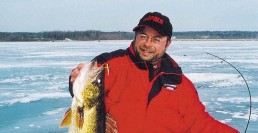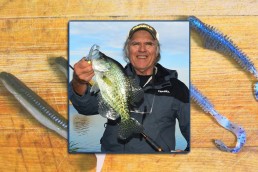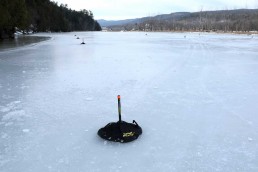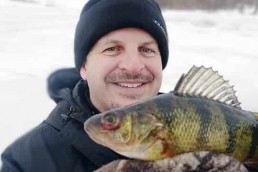The Ups and Downs of the Most Popular Ploy
SHARE THIS POST
I am often asked what technique I use most to catch walleyes—the answer, by far, is vertical jigging.
Although it rates right up there, it’s not because the tactic out-fishes all others. Rather, it’s the one ruse you can use all year, including this upcoming spring. And the tactic works wonders for catching walleyes in all types of waterways, from natural lakes to reservoirs and rivers, and in clear or stained water.
Is the technique a no-brainer to use?
Nope. Not even close.
I guess you could say it has its ups and downs (pun intended). Overall, there are a lot of little details that make a big difference that you must pay attention to if you want to get bit.
Fish where they are
First and foremost, you need to jig where the fish are, and not in the 90 percent of any water they aren’t. I know this sounds obvious, but many anglers overlook this fact. And this does not just mean fishing in likely areas where walleyes might roam, but pinpointing and jigging directly overhead where they are.
Modern electronics are one of the biggest changes for the better when it comes to fishing verses catching.
When I was a kid fishing with my father and grandfather, it was very difficult to isolate specific structure, as well as the exact water depths that surrounded it. And we wouldn’t even know if there were fish in the area unless we spent a lot of time with lines deployed. Basically, if we caught fish then we figured the fish were there; if we didn’t, we’d move on and start over again.
Nowadays, on both on the dash and at the bow of my Lund Pro-V, you’ll find Lowrance sonar units with GPS. And in the card reader of both, an SD card, by Navionics, is filled with detailed mapping any lake, river or reservoir I am on.
The nitty-gritty of it all is the in details of the Navionics mapping program. Navionics help me pin down where, exactly, all the humps, bumps, underwater points and holes are, allowing me to position my boat directly over the breaklines. And for the most part, it is on the breaklines nearest to any structure where the walleyes will be.
Why two units? The one on the dash is for when one of my two outboards is running—either the 250-hp when I’m heading to a spot or the 9.9-hp, 4-stroke for when I am trolling, and the one at the bow is for when my bow-mounted electric trolling motor is deployed and I am casting crankbaits or jigging.
Why have my bow-mounted electric set up and running when vertical jigging? Because good boat control leads to perfect jig and jigging control. And all are crucial when it comes to catching walleyes for all fish for that matter.
Vertical means vertical
Look up the definition of the word “vertical” and you’ll find the answer to be, “at right angles to a horizontal plane; in a direction, or having an alignment, such that the top is directly above the bottom.”
In short, this means vertical is vertical. And when you’re jigging and your line is at an angle—any angle at all—then you are not vertical jigging.
Are you enjoying this post?
You can be among the first to get the latest info on where to go, what to use and how to use it!
My bow-mounted electric trolling motor is crucial when it comes to keeping my jig rising and falling flawlessly vertical. My foot is always on the control petal pushing forward hard, reversing lightly (or again hard) or right and left—it doesn’t matter. Adjusting the position of my Lund so that my line is continuously vertical is the key to catching.
Sight seen, not unseen
The fishing line I use when vertical jigging is the next most important piece of equipment. It needs to be ultra-sensitive, so as to feel the lightest strikes, and thin enough in diameter to “slice” through the water and create very little drag. It needs to be bright in color so it’s easily seen. Whatever you do, don’t worry about the ‘eyes eyeing that bight line because they don’t care.
By far, Berkley’s FireLine in 6-pound-test and in “Flame” (bright green) color is the best I have found for vertical jigging. It’s a superline that has nearly no stretch, has an ultra-thin diameter (the same, if not less than 2-pound monofilament) and its color lets it stand out from the background, making it very easy for me to see if it is at an angle and my boat is drifting too quickly, as well helping to detect strikes. Often, I’ll see the line twitch the instant a walleye strikes before feeling it.
A rod made just for jigging is essential. Personally, I use Fenwick’s EliteTECH Walleye spinning rods built for vertical jigging. Their 6-foot 3-inch medium-power fast-action rod is just right. And I couple it with an Abu Garcia spinning reel. Their entire line of spinning reels is the most multi-species-friendly, because they work wonders when I crank the drag “down to nothing” (no line pulling out) when fighting fish that don’t make hard runs like walleyes, yet have a superior drag when needed for fish like steelhead and salmon that require an ultra-smooth drag system.
Heavy metals
Two types of jigs come to mind when it comes to vertical jigging, and that’s the ball-shaped lead-headed jig tipped with live or fake bait and minnow-shaped lures that sit horizontally in the water.
Northland Fishing Tackle’s Gum-Ball Jig in Neon-Tone colors is my go-to. They come in seven sizes, from 1/32 to 1/2 ounce to cover every need. (Tip: Always use the lightest weight jig you can get away with when jigging. They move much more naturally in the water.)
When using a lead head jig, I always either tip it with live bait fresh from my bait container (minnows, leaches, crawlers) or with a Berkley Gulp product (minnows, leaches, crawlers, etc.). Both live bait and Gulp give off scent, which is important.
As for a jig with a horizontal profile in the water, I find Rapala’s Snap Rap offers not only a straight-up-and-down presentation, but also has a slight glide to it on the fall that walleyes just love. And there’s no need to tip the Snap Rap with bait, live or fake. In fact, it is not suggested, as it will impede the action of the lure.
Slow and easy wins the race
The jigging action you should employ is not much of a lift and fall at all. Overall, a mere raising and lowering of the rod tip about 12 inches is all that’s needed to employ plenty of action; too much can actually spook fish.
In the end
Looking to land a limit of walleyes during your next outing? Who wouldn’t?
Use both sonar and GPS, coupled with a mapping program, and you’ll find the fish faster and easier than ever before. And keep your boat under perfect control at all times. Next, use rods, reels and line made just for the technique. Tip your lead head jigs with live bait or imitations with plenty of scent. Lastly, jig, but not too aggressively.
Mark Martin is a professional walleye tournament angler and instructor with the Ice- Fishing School/Vacation series. Check out his website at markmartins.net or fishingvacationschool.com for more information.
MWO
SHARE THIS POST
Did you enjoy this post?
You can be among the first to get the latest info on where to go, what to use and how to use it!
Mark Martin
Mark Martin is a professional walleye tournament angler and instructor with the Ice Fishing School/Vacation series. For more information, check out his website at markmartins.net or fishingvacationschool.com.




